Twilight of the Horse Cavalry 1919-1944
Who knows when the first warrior boosted himself up on a horse and went into battle? For millennium we have had the image of the mounted warrior in our psyche: the emperor, king, knight, samurai, trooper, brave. We will never know just when it started but in the life time of living people these proud and ancient traditions have come to an end.
Here in America cavalry was used extensively and effectively during the American Civil War and during the Indian Wars that followed. However, during the Spanish-American War and the First World War cavalry saw only limited use. At the same time motor vehicles, heavy artillery, aircraft and rapid fire weapons were perfected. At the end of World War One the future of horse cavalry as a combat arm became a legitimate topic of discussion. Traditionalists held on to the notion of mounted combat, while realists saw a mechanized future.
|
| 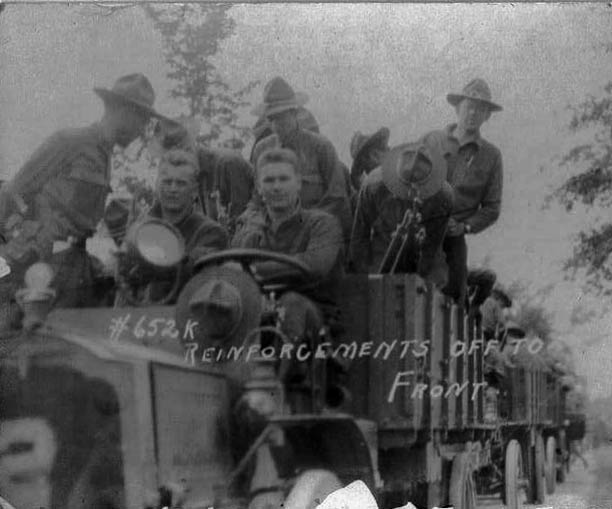
|
|
| Motor transport of troops became common in World War One
|
During the years between 1919 and 1942 the United States maintained a decent sized force of true cavalry regiments, both as part of the Regular Army of the United States and the National Guard (under authority of the various states) and Reserves (a federal force, not on active duty but subject to call). What will follow is a listing of these units and their identities. There were many organizational changes during the period. I hope I have found all the relevant information but mistakes are always possible.
The titles or designations of military units have remained a constant since the 19th century but their composition and relative importance has changed with various army reorganizations over the years. The relative size of the units that we are discussing would be: division larger than brigade, which is larger than regiment, which is larger than squadron (or battalion) which is larger than a troop (also called company in other branches). The unit name is generally preceded or followed by an alphanumeric designator; for example, “2nd Cavalry Regiment” or “Troop C.” It should also be mentioned that some of these units were authorized but never functioned or functioned in only in a very limited form.
The general idea was if the skeleton of a unit existed that in time of war it could be brought up to full strength faster than if no skeleton existed. It was not unusual for a regiment to have only three active troops during this period and many of those were understrength. Particularly the reserve units were top heavy with officers and many needed to borrow mounts from other units more active units for training purposes.
For most of this period divisions had a "square" table of organization. That is to say they consisted as two brigades of two regiments each. In 1939 the Army began a reorganization into "triangular divisions" in which divisions had only three regiments and these were not apportioned to brigades. Brigades disappeared as a subdivision of divisions but might exist as a separate unit.
It would be incorrect to think that in peacetime these units were doing nothing. They were very active and had a strong sense of mission. They were involved in military training, equestrian competitions, ceremonial and escort duties, maintaining public order (national guard units), running C.M.T.C. (Citizen Military Training) and C.C.C. (Civilian Conservation Corps) camps, and assisting during natural disasters.
There also was a strong association between the various components. Officers of the National Guard and of the Organized Reverses attended courses of instruction at the Cavalry School at Fort Riley, Kansas. In this way they became acquainted with their fellow officers serving in other components and received common instruction in doctrine, tactics and leadership. The school also offered advance training in equitation.
Below I will compile a listing of the various cavalry units that existed during the period 1919-1944 but will omit those that were cavalry in name but never mounted. This is presented as a reference list but does illustrate that there were more than a few mounted units during the period in question.
CAVALRY DIVISIONS
During this period many divisions existed on paper and not as true functioning units. The factor that defined a true functioning division was if it had an active headquarters unit and a commander. In those cases in which the division existed on paper, the subordinate cavalry regiments were in existence and functioned normally as independent units. In theory they were assigned to a numbered division at such time that division would be fully activated. The divisions of the Organized Reserve were an exception. All of them had functioning headquarters units and commanders but they were short on enlisted personnel. It is very expensive to maintain a mounted unit. Horses require regular care, stabling, forage, exercise, tack, etc. and it all added up. The cost of maintaining an infantry unit was much less than a cavalry one.
Regular Army Divisions
First Cavalry Division
|
| 
|
|
| Shoulder Sleeve Insignia of the First Cavalry Division
|
The First Cavalry Division was activated at September 12, 1921 at Fort Bliss (located in both New Mexico and Texas). Of all the divisions under discussion, the First Cavalry Division functioned as a true division for most of the period under discussion. Originally, it consisted of the 1st, 7th, 8th and 10th Cavalry Regiments. In 1922 the 10th Cavalry Regiment was removed and the 1st Cavalry Regiment was assigned. In 1933 the 12th Cavalry Regiment was assigned to the division and the 1st Cavalry Regiment was placed in the independent 7th Cavalry Brigade (Mechanized). It began being dismounted and transformation into an infantry division (retaining the cavalry title) on February 1, 1943. It would serve in the Pacific Theater as the war progressed.
Second Cavalry Division
Shoulder Sleeve Insignia of the Second Cavalry Division
(Early World War Two Era)
|
| 
|
|
The Second Cavalry Division for most of this period existed on paper, having been constituted on 20 August 1921, but no headquarters unit was established. In 1925 it consisted of the 4th, 10th, 11th and 13th Cavalry Regiments. A reorganization of 1927 changed this to the 2nd, 4th, 12th and 14th Cavalry Regiments. The 2nd also had a nearly complete compliment of support units assigned to it and might have easily become a functioning division during this period. On 1 April 1941 a divisional headquarters unit was finally activated and the 2nd was a fully functioning division of the Regular Army. One of its brigades, the 4th, consisted of the famous Buffalo soldier units: the 9th and 10th Cavalry Regiments. However, as part of the transition to a mechanized force, the division was inactivated on July 15, 1942 at Fort Riley Kansas. It was decided to reorganize the division as a secreted African-American unit, which was activated at Fort Clark, Texas on 25 Feb 1943. At that time the division contained the 9th, 10th, 27th and 28th Cavalry Regiments. This division was deployed to North Africa in March 1944 where it was somewhat ignominiously broken up and its personnel assigned to logistical units.
Third Cavalry Division
Shoulder Sleeve Insignia of the
Third Cavalry Division
|
| 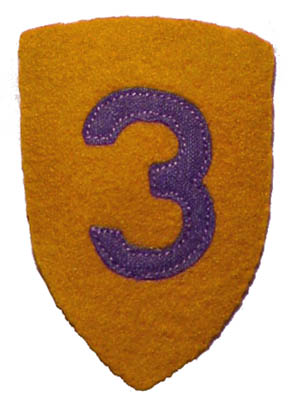
|
|
The Third Cavalry Division was constituted on 15 August 1927 but existed on paper only for much of the period. It was disbanded on October 10, 1940. In 1928 the 3rd, 6th, 10th, and 11th Cavalry Regiments were assigned to the 3rd Cavalry Division. In 1939 it was the 3rd, 6th, 9th, and 10th Cavalry Regiments but the 3rd was removed that year. The design for the patch was approved by the War Department on February 27, 1928 but original examples of it are uncommon. The book "Emblems of Honor" by Kurt Keller shows two photographs of soldiers wearing 3rd Calvary Division patches and one example of an original prewar patch.
National Guard Cavalry Divisions
21st Cavalry Division
Shoulder Sleeve Insignia of the 21st Cavalry Division Made for Collectors Early Postwar Period? According to Richard Smith the 21st patch was the was not approved by the War Dept.
|
| 
|
|
The 21st Cavalry Division constituted on 15 August 1927 but existed on paper only for most of the period until a headquarter unit was organized July 5, 1940. It was to be composed of National Guard Cavalry Units from the states in the northeastern United States, many of which were very active during the period. However, after a very brief time the Army decided to disband the 21st Cavalry Division on 1 November 1940. In 1922 the Division was assigned the 101st, 102nd, 103rd and 104th National Guard Cavalry Regiments. In 1940 the Division had the 101st, 102nd, 110th and 121st National Guard Cavalry Regiments.
22nd Cavalry Division
The 22nd Cavalry Division was constituted in 1921. Like many other cavalry division of the period it existed as a division mainly on paper. Its component units functioned independently with many of its units in the upper middle states. In 1922 the 105th, 106th, 107th and 108th National Guard Cavalry Regiments were assigned to the 22nd. In 1939 there was a major reorganization in which the headquarters was changed from Wisconsin to Pennsylvania and the 105th and 106th Cavalry Regiments were moved to the 23rd Division and the 103rd and 104th moved to the 22nd. On January 3, 1940 a Division HQ was recognized and the unit participated in First Army maneuvers in August 1940. By all accounts they did well but in November the division was disbanded.
23rd Cavalry Division
The 23rd Cavalry Division was constituted in 1921 and its National Guard units concentrated in the southern United States, but one of its regiments was based in far off Boston, Massachusetts. In 1922 it consisted of the 109th, 110th, 111th and 112th National Guard Cavalry Regiments. In 1939 a division HQ was recognized and 105th and 106th Cavalry Regiments were moved to the 23rd Division. At the same time the 111th and 112th removed from the 23rd and retained as parts of a separate 56th Cavalry Brigade. The new division participated in the well-known Louisiana Maneuvers. However, in November 1940 and in keeping with the War Department policy favoring mechanization the division was disbanded.
24th Cavalry Division
|
| 
|
|
|
| Shoulder Sleeve Insignia of the 24th Cavalry Division
Made for Collectors Early Postwar Period ?
According to Richard Smith the 24th was the only
N.G. Cavalry Division with an approved patch.
|
|
The 24th Cavalry Division constituted in 1921 was to be composed of National Guard Cavalry Units from the states of northern western states. It consisted of the 113th, 114th, 115th and 116th National Guard Cavalry Regiments. Its headquarters unit was recognized in 1936. It was very active in various training exercises during the 1930s but like the other National Guard cavalry regiments it was deactivated in November 1940.
Reserve Divisions
These are likely postwar made-for-collectors except for the 65th.
61st Cavalry Division

|
|
62nd Cavalry Division

|
|
63rd Cavalry Division

|
|
64th Cavalry Division

|
|
65th Cavalry Division

|
|
66th Cavalry Division

|
|
61st Cavalry Division
The 61st Cavalry Division, constituted in 1921 as part of the organized reserve, was composed of Reserve Cavalry Units from Delaware, New York and New Jersey. It consisted of the 301st, 302nd, 303rd and 304th Reserve Cavalry Regiments. It was very active in the prewar years but with the outbreak of hostilities in 1941 its personnel were called to active duty elsewhere. On January 30,1942 it was disbanded.
62nd Cavalry Division
The 62nd Cavalry Division, constituted in 1921 as part of the organized reserve, was to be composed of Reverse Cavalry Units from Maryland, Pennsylvania, Virginia and the District of Columbia. It consisted of the 305th, 306th, 307th and 308th Reserve Cavalry Regiments. On January 30,1942 it was disbanded.
63rd Cavalry Division
The 63rd Cavalry Division, constituted in 1921 as part of the organized reserve, was to be composed of cavalry units from Alabama, Florida, Georgia, Louisiana, Mississippi, North Carolina, Oklahoma, South Carolina, Tennessee and Texas. It consisted of the 309th, 310th, 311th and 312th. On January 30,1942 it was disbanded.
64th Cavalry Division
The 64th Cavalry Division, constituted in 1921 as part of the organized reserve, was centered on reserve components in Kentucky but included other from as far away as New England. It consisted of the 313th, 314th, 315th and 316th. On January 30,1942 it was disbanded.
65th Cavalry Division
The 65th Cavalry Division, constituted in 1921 as part of the organized reserve, had units from Illinois, Wisconsin and Michigan. It consisted of the 317th, 318th, 319th and 320th. On January 30,1942 it was disbanded.
66th Cavalry Division
The 66th Cavalry Division, constituted in 1921 as part of the organized reserve, had units from the western United States. It consisted of the 321st, 322rd, 323rd and 324th. On January 30,1942 it was disbanded.
CAVALRY BRIGADES
There were many similarities in the situation between division and brigades. At various time they existed on paper. Each brigade consisted of two cavalry regiments and in general there were two brigades to a division. In some cases brigades functioned independently and were not assigned to a division. For the most part brigades did not have individual shoulder sleeve insignia.
Regular Army Brigades
First Cavalry Brigade
1st Cavalry Brigade was activated in 1921 as part of the First Cavalry Division. Its component regiments were the 1st Cavalry 1921-1933, 10th Cavalry Regiment 1921-1923, 5th Cavalry Regiment 1923-1941 and 12th Cavalry Regiment 1933-1941.
Second Cavalry Brigade
2nd Cavalry Brigade was activated in 1921 as part of the First Cavalry Division. Its component regiments were the 7th Cavalry 1921-1941 and 8th Cavalry Regiment 1921-1941.
Third Cavalry Brigade
3rd Cavalry Brigade was activated in 1921 as part of the Second Cavalry Division. Its component regiments were the 4th Cavalry 1923-1933 and 1936-1940, 10th Cavalry Regiment 1924-1927, 2nd Cavalry Regiment 1927-1941 and 13th Cavalry Regiment 1933-1936.
Fourth Cavalry Brigade
4th Cavalry Brigade was activated in 1921 as part of the Second Cavalry Division. Its component regiments were the 12th Cavalry 1923-1933, 13th Cavalry Regiment 1923-1927, 14th Cavalry Regiment 1927-1940 and 11th Cavalry Regiment 1933-1940, 9th Cavalry 1940-1944 and 10th Cavalry Regiment 1940-1944. On February 25, 1943 it was reassigned to the reorganized 2nd Cavalry Division at Fort Clark, Texas. It was inactivated on March 23, 1944 in North Africa.
Fifth Cavalry Brigade
5th Cavalry Brigade constituted in 1927 as part of the Third Cavalry Division. Its component regiments were the 10th Cavalry 1927-1940, 11th Cavalry Regiment 1927-1933, and 9th Cavalry Regiment 1933-1940. It was disbanded in October 1940. It was reactivate February 25, 1943 as a segregated African-American unit that was part of the 2nd Cavalry Division and contained the 27th and 28th Cavalry Regiments. It was inactivated on June 12, 1944 in North Africa.
Sixth Cavalry Brigade
The 6th Cavalry Brigade was constituted in 1927 as part of the Third Cavalry Division. Its component regiments were the 3rd Cavalry 1927-1940, and the 6th Cavalry Regiment 1927-1940. It was disbanded in October 1940.
Seventh Cavalry Brigade
The 7th Cavalry Brigade (Mechanized) was constituted in 1927 as part of the First Cavalry Corps. Its component regiments were the 1st Cavalry 1933-1940, 4th Cavalry Regiment 1933-1936, 13th Cavalry Regiment 1936-1940. It was reorganized as the First Armored Division in July 1940.
Washington Provisional Cavalry Brigade
The Washington Provisional Cavalry Brigade had the 3rd Cavalry Regiment 1939-1942 and was deactivated May 5, 1942.
National Guard Brigades
51st Cavalry Brigade (New York National Guard)
The 51st Cavalry Brigade, constituted in 1921 as part of the 21st Cavalry Division, organized a headquarters unit in 1922. Its component regiments were the 101st Cavalry 1921-1940, the 102nd Cavalry 1921-1928 and the 121st Cavalry Regiment 1928-1940. It was deactivated in November 1940.
52nd Cavalry Brigade (Pennsylvania National Guard)
|
| 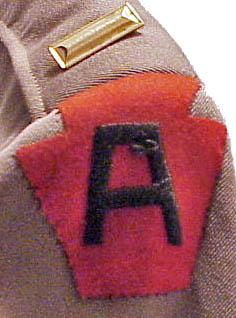
|
|
| Shoulder Sleeve Insignia of the 52nd Cavalry Brigade 1920s
|
The 52nd Cavalry Brigade, constituted in 1921 as part of the 21st Cavalry Division, organized a headquarters unit in 1920. It has the historic First Troop Philadelphia City Calvary that functioned as the headquarters troop. In 1938 it was removed from the 21st Cavalry Division and assigned to the 22nd Cavalry Division. Its component regiments were the 103rd Cavalry 1921-1940, and the 104th Cavalry 1921-1940. It was deactivated in November 1940.
53rd Cavalry Brigade (Wisconsin and Illinois National Guard)
The 53rd Cavalry Brigade, constituted in 1921 as part of the 22nd Cavalry Division, organized a headquarters unit in 1925. In 1938 it was removed from the 22nd Cavalry Division and assigned to the 23rd Cavalry Division. Its component regiments were the 105th Cavalry 1921-1940, and the 106th Cavalry 1921-1940. It was deactivated in September 1940.
54th Cavalry Brigade (Ohio National Guard)
The 54th Cavalry Brigade, constituted in 1921 as part of the 22nd Cavalry Division, organized a headquarters unit in 1922. In 1938 it was removed from the 22nd Cavalry Division and assigned to the 23rd Cavalry Division. Its component regiments were the 107th Cavalry 1921-1940, and the 108th Cavalry 1921-1927 and the 123th Cavalry 1929-1940. It was deactivated in November 1940.
55th Cavalry Brigade (North Carolina or Alabama and Louisiana National Guard)
The 55th Cavalry Brigade, constituted in 1921 as part of the 23rd Cavalry Division, organized a headquarters unit in 1927. In 1933 its headquarters were moved from North Carolina to Alabama. Its component regiments were the 109th Cavalry 1921-1940, and the 110th Cavalry 1921-1927 and the 108th Cavalry 1927-1940. It was deactivated in November 1940.
56th Cavalry Brigade (Texas National Guard)
|
| 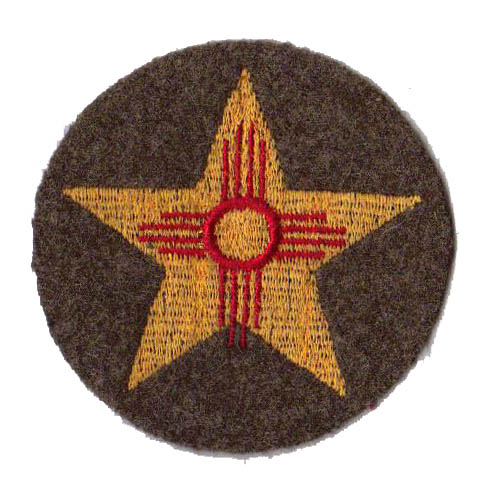
|
|
| Shoulder Sleeve Insignia of the 56th Cavalry Brigade
|
The 56th Cavalry Brigade was constituted on August 23, 1919 with units from both Texas and New Mexico National Guards. It 1921 it became part of the 23rd Cavalry Division and organized a headquarters. Its parent unit was the First Texas Cavalry Brigade, which served during the First World War in Texas. Its component regiments were the 111th (New Mexico National Guard) 1921-1929, 112th 1921-1941 and 124th 1929-1941. With the creation of the 124th Cavalry Regiment in 1929 both of its cavalry regiments were Texas National Guard ones. This unit had the distinction of being federalized in 1940. The 112th and 124th Cavalry Regiments were removed from the brigade but retained their identities and served during World War Two in the Pacific theater. The Headquarters and Headquarters troop were re-designated the 56th Reconnaissance Troop in 1944.
57h Cavalry Brigade (South Dakota or Iowa and Kansas National Guard)
The 55th Cavalry Brigade, constituted in 1921 as part of the 24th Cavalry Division, organized a headquarters unit in 1930. Its component regiments were the 113th 1921-1940, and the 114th 1921-1941. It was deactivated in September 1940.
58th Cavalry Brigade (Wyoming and Idaho National Guard)
The 58th Cavalry Brigade, constituted in 1921 as part of the 24th Cavalry Division, organized a headquarters unit in 1926. Its component regiments were the 115th 1921-1940, and the 116th 1921-1941. It was deactivated in October 1940.
59th Cavalry Brigade (Massachusetts or New Jersey National Guard)
The 59th Cavalry Brigade was constituted in 1927 as part separate brigade. Originally it was allotted to Massachusetts but failed to organize a headquarters unit. In 1937 it was reassigned to New Jersey and did organize a headquarters. Its component regiments were the 102nd 1928-1940, the 122nd 1928-1937 and the 110th 1937-1940. It was deactivated in September 1940.
Organized Reserves Brigades
151th Cavalry Brigade (Organized Reserves)
The 151th Cavalry Brigade was constituted in 1921 as part of the 61st Cavalry Division in the 2nd Corps area. IT organized a headquarters unit in 1922. Its component regiments were the 301st 1921-1941 and the 302nd 1921-1941. It was disbanded in January 1942.
152nd Cavalry Brigade (Organized Reserves)
The 152nd Cavalry Brigade was constituted in 1921 as part of the 61st Cavalry Division in the 2nd Corps area. It organized a headquarters unit in 1922. Its component regiments were the 303rd 1921-1941 and the 304th 1921-1941. It was disbanded in January 1942.
153rd Cavalry Brigade (Organized Reserves)
The 153rd Cavalry Brigade was constituted in 1921 as part of the 62nd Cavalry Division in the 3rd Corps area. It organized a headquarters unit in 1922. Its component regiments were the 305th 1921-1941 and the 306th 1921-1941. It was disbanded in January 1942.
154th Cavalry Brigade (Organized Reserves)
The 154th Cavalry Brigade was constituted in 1921 as part of the 62nd Cavalry Division in the 3rd Corps area. It organized a headquarters unit in 1922. Its component regiments were the 307th 1921-1941 and the 308th 1921-1941. It was disbanded in January 1942.
155th Cavalry Brigade (Organized Reserves)
The 155th Cavalry Brigade was constituted in 1921 as part of the 63nd Cavalry Division in the 4th Corps area. It organized a headquarters unit in 1922. Its component regiments were the 309th 1921-1941 and the 310th 1921-1941. It was disbanded in January 1942.
156th Cavalry Brigade (Organized Reserves)
The 156th Cavalry Brigade was constituted in 1921 as part of the 63nd Cavalry Division in the 4th Corps area. It organized a headquarters unit in 1922. Its component regiments were the 311th 1921-1941 and the 312th 1921-1941. It was disbanded in January 1942.
157th Cavalry Brigade (Organized Reserves)
The 157th Cavalry Brigade was constituted in 1921 as part of the 64th Cavalry Division in the 5th Corps area. It organized a headquarters unit in 1922. Its component regiments were the 313th 1921-1941 and the 314th 1921-1941. It was disbanded in January 1942.
158th Cavalry Brigade (Organized Reserves)
The 158th Cavalry Brigade was constituted in 1921 as part of the 64th Cavalry Division in the 5th Corps area. It organized a headquarters unit in 1922. Its component regiments were the 315th 1921-1941 and the 316th 1921-1941. It was disbanded in January 1942.
159th Cavalry Brigade (Organized Reserves)
The 159th Cavalry Brigade was constituted in 1921 as part of the 65th Cavalry Division in the 6th Corps area. It organized a headquarters unit in 1922. Its component regiments were the 317th 1921-1941 and the 318th 1921-1941. It was disbanded in January 1942.
160th Cavalry Brigade (Organized Reserves)
The 160th Cavalry Brigade was constituted in 1921 as part of the 65th Cavalry Division in the 6th Corps area. It organized a headquarters unit in 1922. Its component regiments were the 319th 1921-1941 and the 320th 1921-1941. It was disbanded in January 1942.
161st Cavalry Brigade (Organized Reserves)
The 161st Cavalry Brigade was constituted in 1921 as part of the 66th Cavalry Division in the 7th Corps area. It organized a headquarters unit in 1922. Its component regiments were the 321st 1921-1941 and the 322nd 1921-1941. It was disbanded in January 1942.
162nd Cavalry Brigade (Organized Reserves)
The 162nd Cavalry Brigade was constituted in 1921 as part of the 66th Cavalry Division in the 7th Corps area. It organized a headquarters unit in 1922. Its component regiments were the 323rd 1921-1941 and the 324th 1921-1941. It was disbanded in January 1942.
CAVALRY REGIMENTS
Regular Army Regiments
First Cavalry Regiment
First Cavalry Distinctive Insignia

| |
The First Cavalry Regiment was originally constituted on March 2, 1833 as the First Regiment of Dragoons. With a reorganization of the mounted branches of the service on August 3, 1861 in was renamed the 1st Cavalry Regiment. In 1921 it was assigned to the First Cavalry Division. On January 16, 1933 it was removed from the 1st Cavalry Division and assigned to the newly created 7th Cavalry Brigade (Mechanized). At the same time it was dismounted after nearly 100 years of mounted service in the U.S. Army and was among the first cavalry units to do so. On January 16, 1933 it was redesignated the 1st Cavalry Regiment (Mechanized). On July 15, 1940 while at Fort Knox, Kentucky it was redesignated the First Armored Regiment (Light) of the First Armored Division. Its distinctive insignia, approved January 26, 1921, features a black hawk, recalling the prior service of some of its officers in the Black Hawk Indian War of 1832. The motto Animo et fide means "Courageous and Faithful" in Latin appears on the representation of a dragoon belt and buckle.
Second Cavalry Regiment
Second Cavalry Distinctive Insignia

|
|
The Second Cavalry Regiment was originally constituted on May 23, 1836 as the Second Regiment of Dragoons. With a reorganization of the mounted branches of the service on August 3, 1861 in was renamed the 2nd Cavalry Regiment. During World War One elements of it served in Europe but it could not claim to have made any major demonstration of the continuing value of traditional cavalry in modern warfare. From 1927 to 1942 it was part of the 2nd Cavalry Division. On July 15, 1942 while at Fort Riley, Kansas it was deactivated as a mounted unit and its personnel and equipment transferred to the 2th Armored Regiment.of the 9th Armored Division.. Its traditions were continued by various mechanized units that followed. Its distinctive insignia, approved January 16, 1923, shows a silver fleur-de-lis, recalling its World War One service in France on an eight-pointed dragoon star that was part of the original dragoon shako plate. The unit's motto Toujours Pręt "Always Ready" in French appears under the insignia.
Third Cavalry Regiment
Training Cavalry Horses, Fort Myer, VA 1935
Tandem Jumping Drill 3rd Cavalry

|
The Third Cavalry Regiment was originally constituted on May 19, 1846 as the Regiment of Mounted Rifles. With a reorganization of the mounted branches of the service on August 3, 1861 in was renamed the 3rd Cavalry Regiment. For much of this time period elements were stationed at Fort Myers and functioned as a ceremonial and escort unit. From 1927-1939 it was assigned to the Third Cavalry Division. In 1939 it was assigned to the independent Washington Cavalry Brigade.
Fourth Cavalry Regiment
The Fourth Cavalry Regiment was originally constituted on March 3, 1855 as the First Cavalry. With a reorganization of the mounted branches of the service on August 3, 1861 in was renamed the 4th Cavalry Regiment. For much of the interwar period elements were stationed in Texas. One distinction of the First Squadron of the 4th, stationed at Ford Meade, South Dakota, was that about one-half of its members were Sioux Indians. The irony of this would have been lost on no one as the same regiment was in combat against the Sioux during the Indiana Wars. From 1923-1933 it was assigned to the Second Cavalry Division. In 1933-1936 it was assigned to the 7th Cavalry Brigade (Mechanized). In 1936 it was returned to the Second Cavalry Division as a horse and mechanized unit.
Fifth Cavalry Regiment
The Fifth Cavalry Regiment was originally constituted on March 3, 1855 as the Second Cavalry Regiment. With a reorganization of the mounted branches of the service on August 3, 1861 in was renamed the 5th Cavalry Regiment. For much of this time period elements were stationed in Texas. In 1922 it was assigned to the First Cavalry Division. It was dismounted on February 28, 1943 and served as infantry during the Second World War as part of the 1st Cavalry Division. Elements of the distinctive insignia of the regiment, approved January 19, 1923, recalls its charge against Confederate infantry at Gaines' Mill in 1862 and its service in Puerto Rico during he Spanish-American War. The arrows recall the units service in the Indian Wars. The regiment's motto "Loyalty and Courage" appears on the sides.
Bugler 10th
Cavalry
H.C. McBarron

|
| |
Sixth Cavalry Regiment
Fifth Cavalry Distinctive Insignia
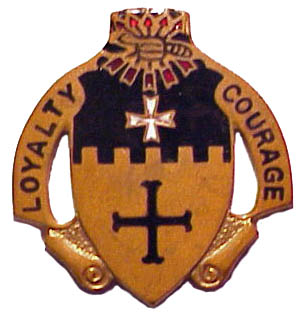
|
|
|
Sixth Cavalry Distinctive Insignia

|
| |
The Sixth Cavalry Regiment was originally constituted on May 4, 1861 as the Third Cavalry Regiment. With a reorganization of the mounted branches of the service on August 3, 1861 in was renamed the 6th Cavalry Regiment. For much of our period of interest in was stationed at Fort Oglethorpe, Georgia. In 1927-1939 it was assigned to the Third Cavalry Division. In 1933 it became a horse mechanized unit. On July 2, 1943 it was redesignated 6th Cavalry Regiment (Mechanized). It was sent to England in 1944 where it was disbanded and elements were reorganized into certain mechanized cavalry reconnaissance units. Its distinctive insignia, approved August 11, 1922, features a unicorn, considered a symbol of knightly virtue in a rampant position, indicating a fighting spirit.
Seventh Cavalry Regiment
The Seventh Cavalry Regiment was originally constituted on July 28, 1866. In 1921 it was assigned to the First Cavalry Division and was stationed at Fort Bliss, Texas for much of the period. The June 25, 1876 Battle of the Little Bighorn, fought in eastern Montana Territory, will long be remembered as an outstanding victory of Native Americans during the Indian Wars. Following the loss of 268 of its men the regiment was rebuilt and is still a component of the U.S. Army. In June 1926 on the 50th anniversary of the battle the 7th Cavalry returned to the battlefield and participated in a touching ceremony with members of the Sioux and Cheyenne tribes, their former enemies. Also attending was White-Man-Runs-Him, a Crow Indian scout and survivor of the battle. He was among a group of Indiana scouts, serving in the U.S. Army and assigned to Custer. Just before Custer's attack, they became convinced they were about to die and removed their Army uniforms and assumed the dress of Crow warriors, stating they wished to die as warriors rather than soldiers. Although history would prove their appraisal of the situation was the better one, Custer was became angered by their action and relieved them from further service, perhaps saving White-Man-Runs-Him's life in the process. The Regiment was dismounted on February 28, 1943 and served during the Second World War as infantry and part of the First Cavalry Division.
Eight Cavalry Regiment
The Eighth Cavalry was originally constituted on July 28, 1866 and organized on September 21, 1868 at Angel Island, California. In 1921 it was assigned to the First Cavalry Division. It was dismounted on February 28, 1943 and served as infantry during the Second World War as a part of the First Cavalry Division in the Pacific Theater of Operations.
Ninth Cavalry Regiment
The Ninth Cavalry Regiment was originally constituted on July 28, 1866. It was an African-American unit that functioned as the Fort Riley Cavalry School Demonstration Regiment for much of our period of interest. In 1933-1940 it was assigned to the Third Cavalry Division. In 1940 it was moved to the Second Cavalry Division. On July 4, 1942 it was moved to Fort Clark, Texas. It remained with the reconstituted Second Cavalry Division on 25 Feb 1943. On March 7, 1944 it was inactivated in North Africa and its personnel transferred to logistical units.
10th Cavalry Regiment
Collar Insignia 10th Cavalry

|
The Tenth Cavalry Regiment was originally constituted on July 28, 1866. The nickname "Buffalo Soldiers" has been generalized to all African-American soldiers in the post-Civil War Regular Army but is believed to have been originated among Cheyenne Indians after their first contact with members of the 10th Cavalry. The 10th was stationed at Fort Huachuca, Arizona at the beginning of our period of interest and later moved to Fort Leavenworth, Kansas. From 1921-1922 it was part of the First Cavalry Division. From 1923-1927 it was assigned to the Second Cavalry Division. From 1927-1940 it was part of the 3rd Cavalry Division. In 1941 it was assigned again to the 2nd Cavalry Division. It remained with the reconstituted Second Cavalry Division on 25 Feb 1943. On March 7, 1944 it was inactivated in North Africa and its personnel transferred to logistical units.
11th Cavalry Regiment
11th Cavalry Distinctive Insignia
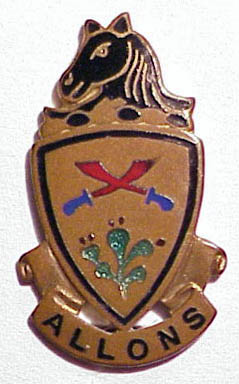
| |
The 11th Cavalry Regiment was originally constituted on February 2, 1901. From 1927-1933 it was part of the Third Cavalry Division. From 1933-1940 it was assigned to the Second Cavalry Division. It was inactivated on July 15, 1942 at Fort Benning, Georgia and personnel and equipment transferred to the 11th Armored Regiment.of the 10th Armored Division. Its distinctive insignia, approved January 26, 1925, features crossed bolos recalling its service in the Philippines and a cactus recalling its service on the Mexican border in 1916. It motto is Allons, which means "Let's Go" in French.
12th Cavalry Regiment
12th Cavalry Distinctive Insignia
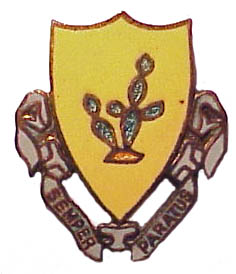
|
|
The 12th Cavalry Regiment was originally constituted on February 2, 1901. From 1923-1933 it was part of the Second Cavalry Division. In 1933 it was assigned to the First Cavalry Division. It was dismounted on February 28, 1943 and served as infantry in the 2nd Cavalry Division during the Second War War in the Pacific Theater. Its distinctive Insignia, approved August 14, 1923, shows a cactus commemorating its service on the Mexican border in 1816. The motto Semper Paratus means "always ready" in Latin.
13th Cavalry Regiment
13th Cavalry Distinctive Insignia
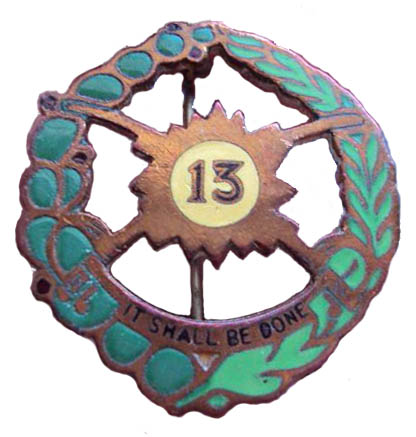
|
| |
The 13th Cavalry was originally constituted on February 2, 1901 and organized at Fort Meade, South Dakota. From 1923-1927 it was part of the Second Cavalry Division. (From 1927-1932 it was an independent unit) From 1932-1936 it was assigned to the Second Cavalry Division again. In 1936 it was assigned to the 7th Cavalry Brigade (Mechanized). In 1940 it was redesignated the 13th Armored Regiment and assigned to the 1st Armored Division. Its distinctive insignia, approved August 30, 1922, features the number 13 over crossed sabers with a wreath of cactus and palm and the motto "It shall be done."
14th Cavalry Regiment
Lapel Insignia 14th Cavalry Officer

|
|
The 14th Cavalry Regiment was originally constituted on February 2, 1901. From 1927-1941 it was part of the Second Cavalry Division and was at Fort Des Moines, Iowa. It was inactivated on July 15, 1942 at Fort Riley, Kansas and personnel and equipment transferred to the 14th Armored Regiment.of the 9th Armored Division.
15th Cavalry Regiment
15th Cavalry Distinctive Insignia
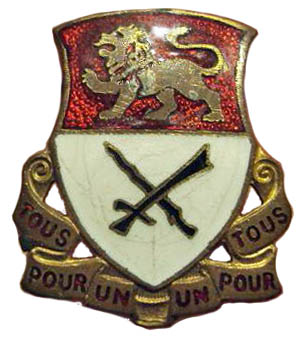
|
| |
The 15th Cavalry was originally constituted on February 2, 1901 and organized February 12, 1901 at the Presidio of San Francisco, California and then sent for service in the Philippines. It was not assigned to any division but existed as an independent unit until it was inactivated on October 18, 1921 at Fort A.D. Russell, Wyoming. In 1927 it was reactivated as a reserve unit in Kansas City, Missouri. In 1940 with the limited mobilization it was redesigned the 15th Cavalry Regiment, Horse and Mechanized. It was activated on March 22, 1942 as the 15th Cavalry Regiment, Mechanized but on March 1, 1944 was inactivated and its components converted into certain mechanized cavalry reconnaissance units. Its distinctive Insignia, approved April 6, 1935, features a golden lion from the arms of the city of Bordeaux recalling its World War One service and crossed kris, recalling its service in the Philippine Insurrection. Its motto Tous pours un, un pours tous means "All for one, one for all" in French.
16th Cavalry Regiment
The 16th Cavalry was originally constituted on July 1, 1916. It was not assigned to any division but existed as an independent unit until 1921 when it was inactivated. In 1927 the designation was given to a reserve unit at Fort Myer, Virginia. It was inactivated in 1938. On June 15, 1942 it was reactivated at Camp Forrest, Tennessee as the 16th Cavalry Regiment, Mechanized.
17th Cavalry Regiment
The 17th Cavalry Regiment was originally constituted on July 1, 1916. It was stationed at Schofield Barracks in Hawaii but in 1921 was transferred to the Presidio in Monterey, California. It was not assigned to any division but existed as an independent unit until 1921 when it was inactivated. In 1927 the designation was given to a reserve unit at Portland, Oregon. In 1940 it was redesigned the 17th Cavalry Regiment, Corps Reconnaissance. It was inactivated in 1941.
26th Cavalry Regiment (Philippine Scouts)
The 26th Cavalry at Morong 1942
"The Last Charge" by John Solie
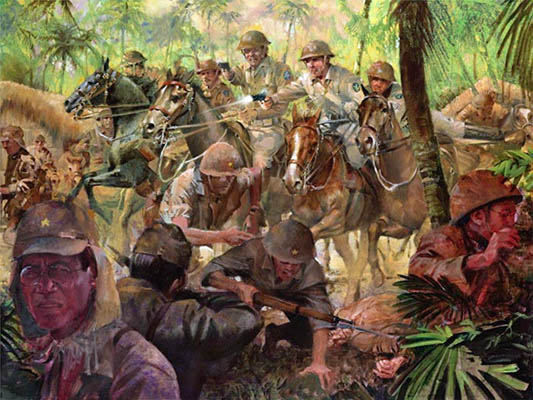
|
The 26th Cavalry Regiment was created on October 1, 1922 in the Philippine Department. It functioned independently of any cavalry brigade or division. The 26th Cavalry Regiment, consisting mostly of Philippine Scouts, was the last U.S. Cavalry Regiment to engage in horse-mounted warfare. Their last mounted charge occurred at the town of Morong on January, 16 1942. The unit fought desperate rearguard actions both mounted and dismounted against the Japanese army throughout the American withdraw in the Philippines. Elements were enveloped by Japanese forces on Bataan and forced to surrender on April 9, 1942. Certain other elements of the regiment avoided the surrender at Corregidor and persisted in guerrilla warfare after the May 6, 1942 American surrender in the Philippines, but the regiment as a whole creased to exist at that date.
27th Cavalry Regiment
The 27th Cavalry was activated on February 25, 1943 at Fort Clark, Texas as a segregated African-American unit that was part of the 2nd Cavalry Division. It arrived in North Africa on March 9, 1944 but was deactivated on March 27, 1944 and its assets transferred to the 6404th Port Battalion.
28th Cavalry Regiment
The 27th Cavalry was activated on February 25, 1943 at Camp Lockett, California as a segregated African-American unit that was part of the 2nd Cavalry Division. It arrived in North Africa on March 129, 1944 but was deactivated on March 31, 1944 and its assets transferred to the 6487th Engineer Battalion.
National Guard Cavalry Regiments
101st Cavalry Regiment (New York National Guard)
101st Cavalry Regiment Trooper
Note the 6th Corps patch to which the 101st was assigned May 1942-Jan 1943.
The photograph shows where distinctive insignia and collar disks were worn.

|
101st Cavalry Distinctive Insignia
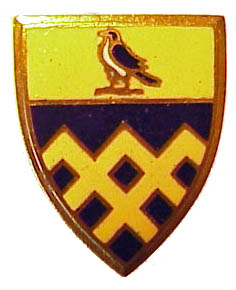
|
|
101st Cavalry Enlisted Collar Disk (Right Side)
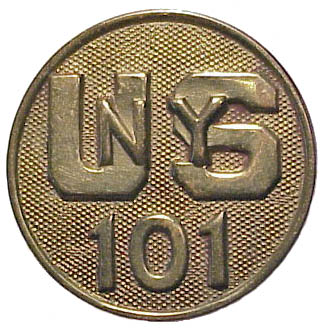
|
|
101st Cavalry Troop K Enlisted Collar Disk (Left Side)
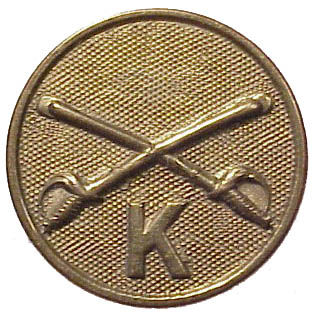
|
|
101st Cavalry Troop K Enlisted Collar Disk (Left Side)
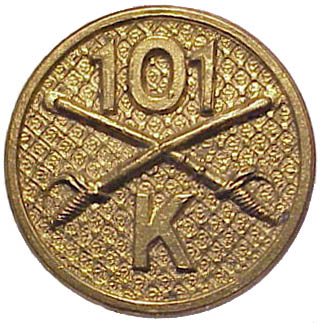
| |
101st Cavalry Officer's Lapel Insignia
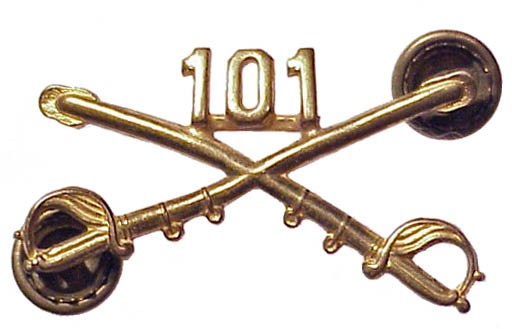
|
|
101st Cavalry Officer's Lapel Insignia
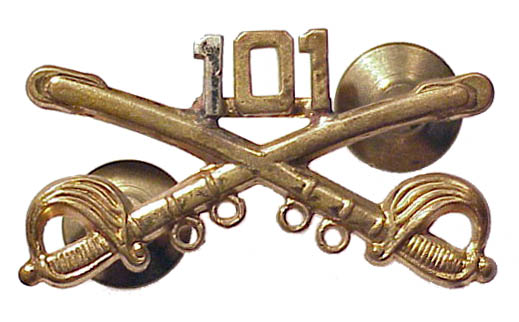
| |
The 101st Cavalry Regiment (New York National Guard) was constituted on 30 Dec 1920 as part of the 21st Cavalry Division. Its parent units were the former First New York Cavalry Regiment and the 105th Machine Gun Battalion. In 1940 it was re-designated 101st Cavalry Regiment Horse and Mechanized and removed from the 21st Cavalry Division. It was inducted into Federal Service on January 27, 1941 at Brooklyn, N.Y. On October 15, 1943 at Camp Ashby, Virginia it was deactivated and elements converted into various mechanized cavalry reconnaissance units. Its distinctive insignia, approved May 20, 1925, features a falcon at rest, indicating the ready for service nature of a national guard unit and three overlapping chevronels symbolizing the three occasions between 1898 to 1919 it was called to federal service.
102nd Cavalry Regiment (New Jersey National Guard)
Enlisted Collar Disk 102nd Cavalry (Right)

| |
102nd Cavalry Distinctive Insignia
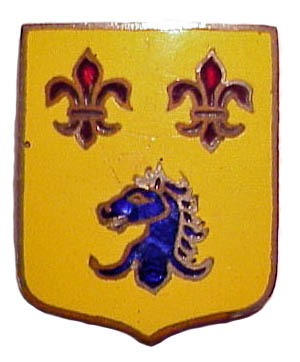
| |
The 102nd Cavalry Regiment (New Jersey National Guard) was constituted in March 1921 as part of the 21st Cavalry Division. The origin of the unit was with the Essex Troop of Light Cavalry, organized in 1890. By 1913 it has expanded to a full squadron, called the First Squadron of Cavalry, New Jersey National Guard. The regiment's horses wore a distinctive chrome yellow brow band and rosette as a part of their bridles, which made them stand out. In 1940 it was re-designated 102nd Cavalry Regiment Horse and Mechanized and removed from the 21st Cavalry Division. It was inducted into Federal Service on January 6, 1941. The 102nd had the additional distinction of being the first national guard cavalry regiment to have its distinctive insignia approved by the War Department. The blue horse's head was the symbol of the Essex Troop and the red fleurs-de-lis commemorates the unit's World War One service in the Alsace and Argonne campaigns.
103rd Cavalry Regiment (Pennsylvania National Guard)
Lapel Insignia 103rd Cavalry Officer
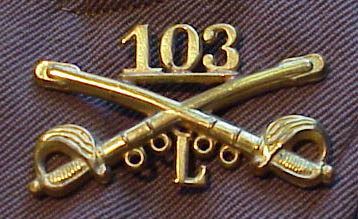
| |
|
103rd Cavalry Distinctive Insignia
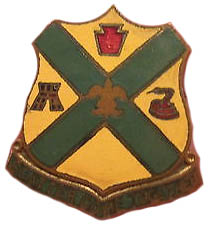
| |
|
Enlisted Collar Disk 103rd Cavalry (Right)
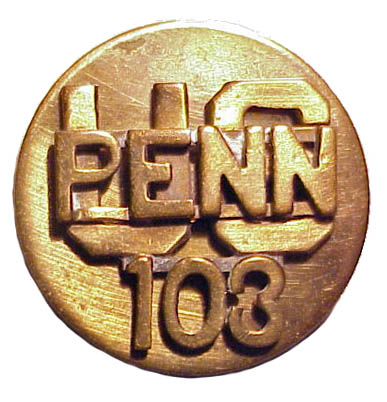
| |
|
Enlisted Collar Disk 103rd Cavalry (Left)
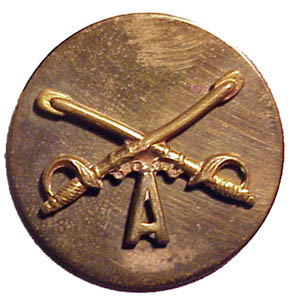
| | |
103rd Cavalry Regiment (Pennsylvania National Guard) was constituted in 1921 as part of the 21st Cavalry Division. Its parent unit was the former First Pennsylvania Cavalry. The historic Second Troop Philadelphia City Cavalry, established in 1776, became Troop B of the 103rd Cavalry Regiment. In 1939 the regiment was removed from the 21st Cavalry Division and placed in the 22nd Cavalry Division. In 1940 it was converted into the 190th Field Artillery Regiment.
104th Cavalry Regiment (Pennsylvania National Guard)
Enlisted Collar Disk 104th Cavalry

| |
104th Cavalry Distinctive Insignia
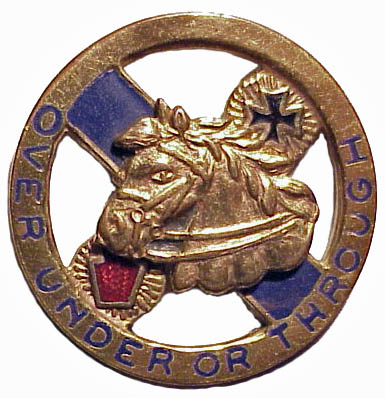
| |
The 104th Cavalry Regiment (Pennsylvania National Guard) was constituted in 1921 as part of the 21st Cavalry Division. In 1939 it was removed from the 21st Cavalry Division and placed in the 22nd Cavalry Division. In 1940 it was removed from the 22nd Cavalry Division and re-designated 104th Cavalry Regiment Horse and Mechanized. It was inducted into Federal Service on February 17, 1941. On January 1, 1944 it was inactivated and its components converted into certain mechanized cavalry reconnaissance units. Its distinctive insignia, approved January 3, 1924, features a horse head, the red keystone of Pennsylvania and a black Maltese cross for its service in Puerto Rico during the Spanish-American War. The motto of the regiment "Over, Under, or Through" appears on the rim.
105th Cavalry Regiment (Wisconsin National Guard)
Enlisted Collar Disk 105th Cavalry (Right Side)
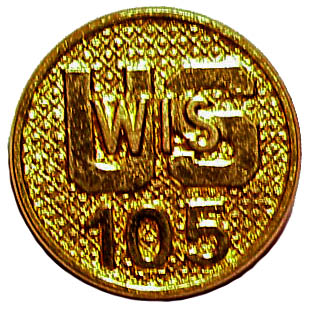
|
|
The 105th Cavalry Regiment (Wisconsin National Guard) was constituted in 1921 as part of the 22nd Cavalry Division. Its parent regiment was the 1st Wisconsin Cavalry Regiment. In 1931 construction was completed on an impressive The Light Horse Squadron Armory complex, located at 4108 North Richards Street, Milwaukee, Wisconsin. The buildings were build with privately raised funds and included the armory, its attached riding hall, the blacksmith shop and forage storage building and the regimental commander’s house. It is a good example of the public support these units enjoyed even in the middle of a depression. In 1939 the regiment was removed from the 22nd Cavalry Division and placed in the 23rd Cavalry Division. In 1940 it was removed from the 23rd Cavalry Division and was redesignated as the 126th Field Artillery Regiment.
106th Cavalry Regiment (Michigan and Illinois National Guard)
The 106th Cavalry Regiment (Michigan and Illinois National Guard) was constituted in 1921 as part of the 22nd Cavalry Division. The headquarters troop of the 106th Cavalry Regiment was a specially uniformed, ceremonial unit that was created in 1927, known as the Chicago Black Horse Troop and Mounted Band. In 1939 the regiment was removed from the 22nd Cavalry Division and placed in the 23rd Cavalry Division. In 1940 it was removed from the 23rd Cavalry Division and was redesignated 106th Cavalry Regiment Horse and Mechanized. It was inducted into Federal Service on November 26, 1940. On March 14, 1944 was inactivated and its components converted into certain mechanized cavalry reconnaissance units.
107th Cavalry Regiment (Ohio National Guard)
Enlisted Collar Disk 107th Ohio (Right)
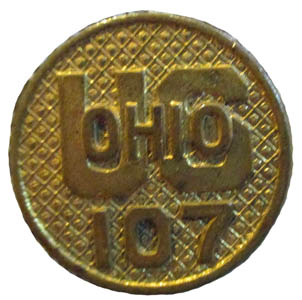
| |
107th Cavalry Distinctive Insignia
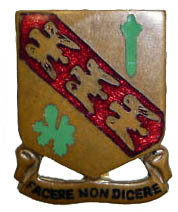
| |
The 107th Cavalry Regiment (Ohio National Guard) was constituted in 1921 as part of the 22nd Cavalry Division. Its parent units include the First Cleveland Troop, established 1886, and later the First Ohio Cavalry Regiment of 1898. In 1939 it was removed from the 22nd Cavalry Division and placed in the 23rd Cavalry Division. In 1940 it was removed from the 23rd Cavalry Division and was redesignated 107th Cavalry Regiment Horse and Mechanized. It was inducted into Federal Service on March 5, 1941. On January 1, 1944 was inactivated and its components converted into certain mechanized cavalry reconnaissance units. Its distinctive insignia was approved on March 8, 1927 and features three Alerion, mythological birds similar to eagles from the arms of Lorraine, recalling its World War One service, a roman sword for its Spanish-American War service and the cactus for Mexican Border duty. Its motto is Facere Non Dicere, which is Latin for "To Act, Not To Speak."
108th Cavalry Regiment (Louisiana and Georgia National Guard)
The 108th Cavalry Regiment (Louisiana and Georgia National Guard) was constituted in 1921 as part of the 22nd Cavalry Division. In 1927 it was removed from the 22nd Cavalry Division and placed in the 23rd Cavalry Division. In 1936 it was withdraw from Louisiana and assigned to Georgia. In 1940 it was removed from the 23rd Cavalry Division and disbanded.
109th Cavalry Regiment (Tennessee, North Carolina and Alabama National Guard)
The 109th Cavalry Regiment (Tennessee, North Carolina and Alabama) was constituted in 1921 as part of the 23rd Cavalry Division. In 1940 it was removed from the 23rd Cavalry Division and converted into the 181st Field Artillery Regiment.
110th Cavalry Regiment (Massachusetts, Rhode Island and Connecticut National Guard)
110th Cavalry Distinctive Insignia

| |
The 110th Cavalry Regiment (Massachusetts, Rhode Island and Connecticut National Guard) was constituted June 1, 1921 as part of the 23rd Cavalry Division. Certain of its troops could trace their lineages to old Boston militia units, such as the National Lancers or Boston Light Dragoons. In 1929 it was removed from the 23rd and elements underwent reorganization. In 1937 it was picked up by the 59th Separate Brigade. In 1939 it was moved to the 21st Cavalry Division. On October 9, 1940 it was removed from the 21st Cavalry Division and converted into the 180th Field Artillery Regiment.
111th Cavalry Regiment (New Mexico and Colorado National Guard)
The 111th Cavalry Regiment (New Mexico and Colorado National Guard) was constituted in 1921 as part of the 23rd Cavalry Division. In 1929 it was removed from the 23rd and elements underwent reorganization. In 1939 it was moved to the 21st Cavalry Division. In 1940 it was converted into the 207th Coast Artillery Regiment (Anti-Aircraft).
112th Cavalry Regiment (Texas National Guard)
The 112th Cavalry Regiment (Texas National Guard) was constituted in July 20, 1921 as part of the 23rd Cavalry Division. Its parent unit was the First Texas Cavalry Regiment. During the 1920s and 1930s it performed extensive martial law duties during various civil disturbances in Texas. In 1939 it was removed from the 23rd and became part of the separate 56th Cavalry Brigade. It was inducted into Federal Service on November 7, 1940 at Dallas, Texas. On August 11, 1942 it was deployed in New Caledonia islands in the southwest Pacific Ocean as a mounted unit, using horses acquired in Australia. On May 17, 1943 they were dismounted and moved to New Guinea, serving the rest of the war as infantry in the Pacific Theater.
113th Cavalry Regiment (Iowa National Guard)
The 113th Cavalry Regiment (Iowa National Guard) was constituted in 1921 as part of the 24th Cavalry Division. Its parent unit was the First Iowa Cavalry Regiment. In 1940 it was removed from the 24th and was redesignated 113th Cavalry Regiment Horse and Mechanized. It was inducted into Federal Service on January 13, 1941.
114th Cavalry Regiment (Kansas and South Dakota National Guard)
Enlisted Collar Disk 114th Kansas (Right)
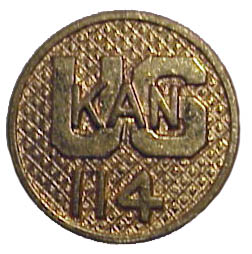
|
|
Enlisted Collar Disk Cavalry
(Left)

| |
The 114th Cavalry Regiment (Kansas and South Dakota National Guard) was constituted in 1921 as part of the 24th Cavalry Division. Its parent unit was the First Separate Kansas Cavalry Squadron. In 1940 it was removed from the 24th and was converted into the 127th Artillery Regiment.
115th Cavalry Regiment (Wyoming National Guard)
The 115th Cavalry Regiment (Wyoming National Guard) was constituted in 1921 as part of the 24th Cavalry Division. Its parent unit was the First Wyoming Cavalry Regiment. In 1940 it was removed from the 24th and was redesignated 113th Cavalry Regiment Horse and Mechanized. It was inducted into Federal Service on February 24, 1941.
116th Cavalry Regiment (Idaho and Utah National Guard)
The 116th Cavalry Regiment (Idaho and Utah National Guard) was constituted in 1921 as part of the 24th Cavalry Division. Its parent units were the First Idaho and the First Utah Cavalry Regiments. In 1940 it was removed from the 24th and was converted into the 183rd Artillery Regiment.
117th Cavalry Regiment (Colorado National Guard)
The 117th Cavalry Regiment (Colorado National Guard) was constituted in 1922 as an independent regiment. In 1931 the regiment as such was disbanded except for one squadron that was renamed the 117th Separate Cavalry Squadron.
121st Cavalry Regiment (New York National Guard)
121st Cavalry Regiment Distinctive Insignia
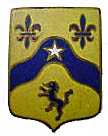
|
121st Cavalry Officer at Camp Pine
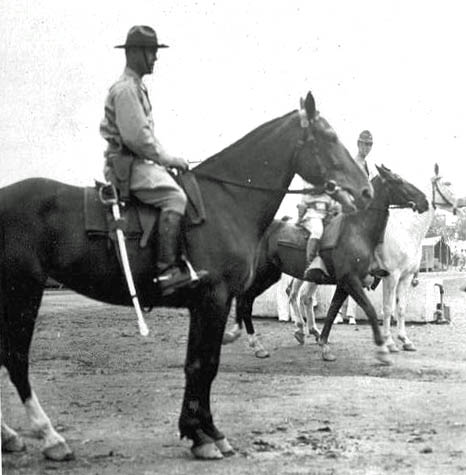
|
|
121st Cavalry Troopers at Camp Pine
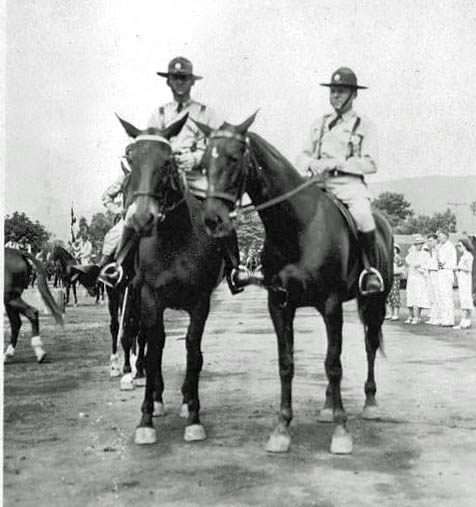
| | |
The 121st Cavalry Regiment (New York National Guard) was constituted in 1928 as part of the 21st Cavalry Division. In 1940 the regiment was removed from the 21st Cavalry Division and its elements converted into several anti-tank and artillery units
122nd Cavalry Regiment (Connecticut and Rhode Island National Guard)
The 122nd Cavalry Regiment (Connecticut and Rhode Island National Guard) was constituted in 1929 as an independent regiment. Among its parent units were the Governors (Connecticut) Independent Volunteer Troop of Horse Guards, originally chartered 19 May 1788. In 1937 the regiment was disbanded except for elements that were transferred to the 110th Cavalry Regiment.
123rd Cavalry Regiment (Kentucky National Guard)
123rd Cavalry on Review at Camp Knox

|
Lapel Insignia 123rd Cavalry Officer
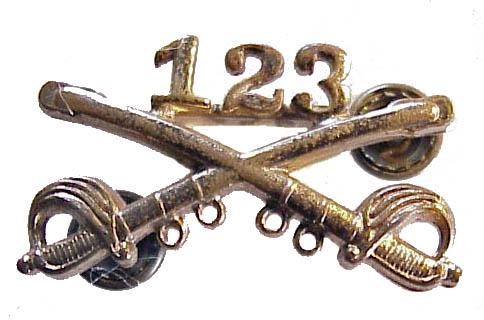
| |
The 123rd Cavalry Regiment (Kentucky National Guard) was constituted in 1929 as part of the 22nd Cavalry Division. In 1940 the regiment was removed from the 22nd Cavalry Division and elements converted into anti-aircraft artillery units.
124th Cavalry Regiment (Texas National Guard)
The 124th Cavalry Regiment (Texas National Guard) was constituted in 1929 as part of the 23rd Cavalry Division. In 1939 the regiment was removed from the 23rd Cavalry Division and assigned to the independent 56th Separate Cavalry Brigade. It was inducted into Federal Service on November 18, 1940.
Organized Reserves Cavalry Regiments
301st Cavalry Regiment (New York Organized Reserve)
The 301st Cavalry Regiment (New York Organized Reserve) was constituted in 1921 and assigned to the 61st Cavalry Division.
302nd Cavalry Regiment (New Jersey Organized Reserve)
302nd Cavalry Regiment (New Jersey Organized Reserve) was constituted in 1921 and assigned to the 61st Cavalry Division.
303rd Cavalry Regiment (New York Organized Reserve)
303rd Cavalry Regiment (New York Organized Reserve) was constituted in 1921 and assigned to the 61st Cavalry Division.
304th Cavalry Regiment (New York Organized Reserve)
304th Cavalry Regiment (New York Organized Reserve) was constituted in 1921 and assigned to the 61st Cavalry Division.
304th Cavalry Officer's Lapel Insignia

| |
305th Cavalry Regiment (Pennsylvania Organized Reserve)
305th Cavalry Regiment (Pennsylvania Organized Reserve) was constituted in 1921 and assigned to the 62nd Cavalry Division.
306th Cavalry Regiment (Maryland and District of Columbia Organized Reserve)
306th Cavalry Regiment (Maryland and District of Columbia Organized Reserve) was constituted in 1921 and assigned to the 62nd Cavalry Division.
307th Cavalry Regiment (Virginia Organized Reserve)
307th Cavalry Regiment (Virginia Organized Reserve) was constituted in 1921 and assigned to the 62nd Cavalry Division.
308th Cavalry Regiment (Maryland and Pennsylvania Organized Reserve)
308th Cavalry Regiment (Maryland and Pennsylvania Organized Reserve) was constituted in 1921 and assigned to the 62nd Cavalry Division.
309th Cavalry Regiment (North Carolina and Georgia Organized Reserve)
309th Cavalry Regiment (North Carolina and Georgia Organized Reserve) was constituted in 1921 and assigned to the 63rd Cavalry Division.
310th Cavalry Regiment (Tennessee and Georgia Organized Reserve)
310th Cavalry Regiment (North Carolina and Georgia Organized Reserve) was constituted in 1921 and assigned to the 63rd Cavalry Division. The unit was disbanded on October 18, 1943.
BOOTS AND SADDLES
Model 1904 McClellan Saddle in Russet-Brown Leather
The saddle had been in use with modifications since 1859.
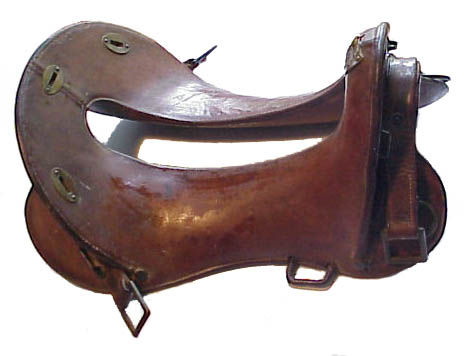
|
|
Officer's Boots
These were privately purchased in various styles.
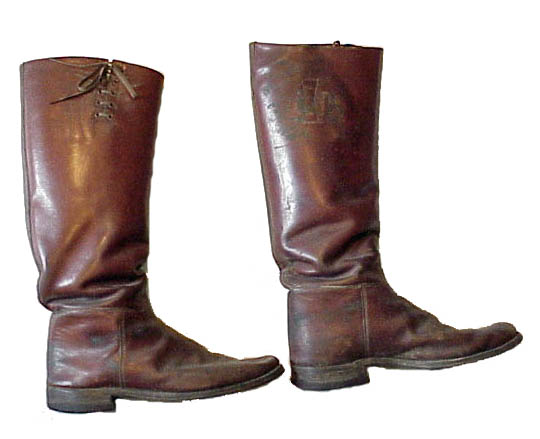
| |
311th Cavalry Regiment (Texas and Arizona Organized Reserve)
311th Cavalry Regiment (Texas and Arizona Organized Reserve) was constituted in 1921 and assigned to the 63rd Cavalry Division. The unit was disbanded on October 18, 1943.
312th Cavalry Regiment (Oklahoma, Arizona, Colorado and New Mexico Organized Reserve)
312th Cavalry Regiment (Oklahoma, Arizona, Colorado and New Mexico Organized Reserve) was constituted in 1921 and assigned to the 63rd Cavalry Division.
313th Cavalry Regiment (Kentucky and Indiana Organized Reserve)
313th Cavalry Regiment (Kentucky and Indiana Organized Reserve) was constituted in 1921 and assigned to the 64th Cavalry Division.
314th Cavalry Regiment (Kentucky and Ohio Organized Reserve)
314th Cavalry Regiment (Kentucky and Ohio Organized Reserve) was constituted in 1921 and assigned to the 64th Cavalry Division.
315th Cavalry Regiment (Rhode Island, Connecticut, Vermont, New Hampshire and Massachusetts Organized Reserve)
315th Cavalry Regiment (Rhode Island, Connecticut, Vermont, New Hampshire and Massachusetts Organized Reserve) was constituted in 1921 and assigned to the 64th Cavalry Division. The unit was disbanded on October 18, 1943.
316th Cavalry Regiment (Rhode Island, Connecticut, Vermont, and New Hampshire Organized Reserve)
316th Cavalry Regiment (Rhode Island, Connecticut, Vermont, and New Hampshire Organized Reserve) was constituted in 1921 and assigned to the 64th Cavalry Division. The unit was disbanded on October 18, 1943.
317th Cavalry Regiment (Illinois Organized Reserve)
317th Cavalry Regiment (Illinois Organized Reserve) was constituted in 1921 and assigned to the 65th Cavalry Division. The unit was disbanded on October 18, 1943.
318th Cavalry Regiment (Illinois Organized Reserve)
318th Cavalry Regiment (Illinois Organized Reserve) was constituted in 1921 and assigned to the 65th Cavalry Division.
Model 1911 August Buermann Spur
This was considered a human spur and Army Issue. It is featured in the patch of the 61st Cavalry Division
|
| 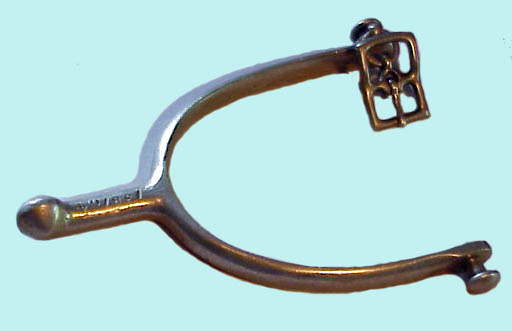
|
319th Cavalry Regiment (Michigan Organized Reserve)
319th Cavalry Regiment (Michigan Organized Reserve) was constituted in 1921 and assigned to the 65th Cavalry Division.
320th Cavalry Regiment (Wisconsin and Illinois Organized Reserve)
320th Cavalry Regiment (Wisconsin and Illinois Organized Reserve) was constituted in 1921 and assigned to the 65th Cavalry Division.
321st Cavalry Regiment (Missouri and Arkansas Organized Reserve)
321st Cavalry Regiment (Missouri and Arkansas Organized Reserve) was constituted in 1921 and assigned to the 66th Cavalry Division.
322nd Cavalry Regiment (Minnesota and North Dakota Organized Reserve)
322nd Cavalry Regiment (Minnesota and North Dakota Organized Reserve) was constituted in 1921 and assigned to the 66th Cavalry Division.
323nd Cavalry Regiment (Oregon, Washington and Nevada Organized Reserve)
323nd Cavalry Regiment (Oregon, Washington and Nevada Organized Reserve) was constituted in 1921 and assigned to the 66th Cavalry Division.
324th Cavalry Regiment (Wyoming, Utah, Idaho and Montana or California Organized Reserve)
324th Cavalry Regiment (Wyoming, Utah, Idaho and Montana or California Organized Reserve) was constituted in 1921 and assigned to the 66th Cavalry Division.
Model 1913 Enlisted Cavalry Sword
perfected by George S. Patton

|
Yes, I have chosen to title this discussion the Twilight of the Horse Cavalry but I might just as well have called it the "golden age" of horse cavalry. It was not a bad time to be a cavalryman. The amenities were far better than those available to those serving during the Indian Wars and one could go to bed free of the worry one might be scalped the next day. It was peacetime and cavalry officers participated in horse shows, polo matches, hunts and enjoyed a high social status, if not a salary that was commiserate with that status. Many, like George Paton, were independently wealthy and forced to struggle so as not to do too well in the poker matches with their less well-off brother officers. The training and the tradition of cavalry helped prepare them for the Second World War even if their horses remained behind. Many would in the years that followed testify that if we only had horse cavalry we could have better exploited this situation or that but I believe it is fair for the most part to say that a horse has no business being on a modern battlefield. Well, there were also those who bemoaned the passing to the dirigible. Although totally lacking in sentimentality, the decision to dismount the horse cavalry was the correct one. The fact is that there remains a group of soldiers with equestrian abilities and when situations arise, as it did with the Special Forces in Afghanistan, the American soldier can still function on horseback.
A Special Note on Insignia

The insignia used to illustration this discussion for the most part date from the 1919 to 1944 period and are representative of the various cavalry units being discussed. However, officers' insignia were privately purchased and more variable than enlisted insignia, which were issued. Photographic evidence is that most officers wore plain crossed sabers without any kind of numbers designating their particular regiment. However, for a small additional charge firms selling insignia would add numbers to them and I have selected examples of them to illustrate the discussion. Another important development during the period was the adoption of lapel coats in place of coats with standing collars in 1926. Officers' insignia moved from the collar to the lapels and became smaller. Enlisted insignia were issued and were more uniform. However, the manner in which they were manufactured changed during the period. In 1924 the Army discontinued the dark bronze disks typical of World War One and adopted disks with a brighter, often gilt surface. Collectors call this type of manufacture either Type I or Type II and examples of both types appear above. Beginning in 1937 these disks types were phased out and a new type, called Type III by collectors was introduced. The two enlisted disks show above for Troop A of the 103rd Cavalry Regiment, Pennsylvania National Guard are examples of this type. Shoulder Sleeve insignia were first worn during World War One and were at first only authorized for units of the American Expeditionary Force in Europe. They were indicative of larger units, such as divisions, while enlisted and officer collar or lapel insignia dictated branch of service, regiment and company. Distinctive insignia were introduced just after World War One as an additional symbol of a soldier's regiment. These were designed by the regiments themselves and purchased through unit funds but were subject to approval by the Institute of Heraldry of the War Department.
|
All images are public domain, contributed by anonymous donors or from the author's collection.
Bibliography
- Clay, Steven E., U.S. Army Order of Battle 1919-1941, Volume 2 (Fort Leavenworth, KS: Combat Studies Institute Press, 2010)
- Elting, John R. and Michael McAfee, Military Uniforms in America: The Modern Era From 1868 (Novato, CA: Presidio Press, 1988)
- Keller, Kurt H., Emblems of Honor: Patches and Insignia of the U.S. Army: Armor, Cavalry, Tank Destroyer and Constabulary (Twin Pond, 2004)
- Stanton, Shelby, Order of Battle U.S. Army, World War II, (Novato, CA: Presidio Press, 1984)
- Stein, Barry Jason, U.S. Army Heraldic Crests (Columbia, S.C.: University of South Carolina Press, 1993)
- Stubbs, Mary Lee and Stanley Russell Connor, Army Lineage Series:Armor-Cavalry (Washington, D.C.:Office of the Chief of Military History, 1969)
- Students of the Cavalry School, The Rasp: The Cavalry School Annual 1927
Evolution of U.S. Army Cavalry Insignia
Back to Discussions about Horse Related Topics
Back to Insignia of World War Two
Additional Information regarding Collar Disks of the U.S. Army
Additional Information regarding Distinctive Insignia of the U.S. Army
Back to Uniforms of the Civil War

































